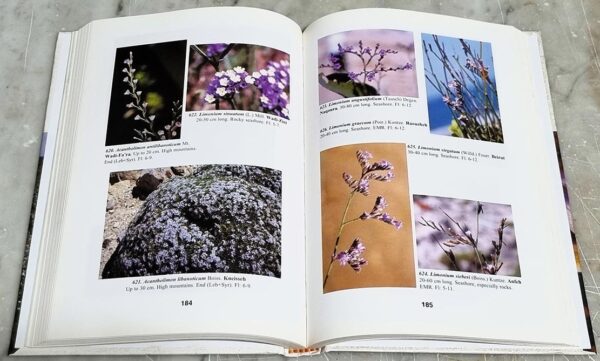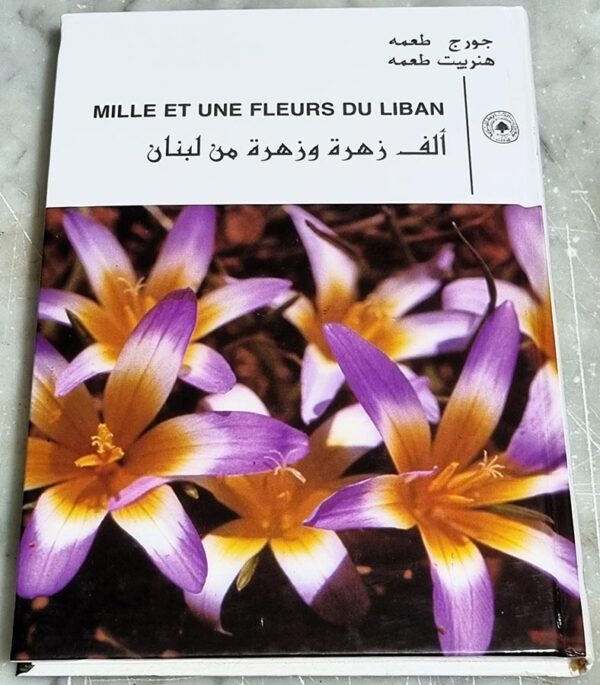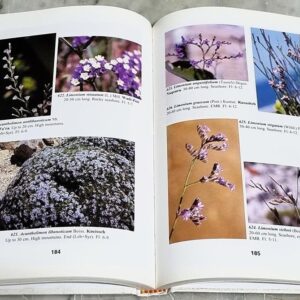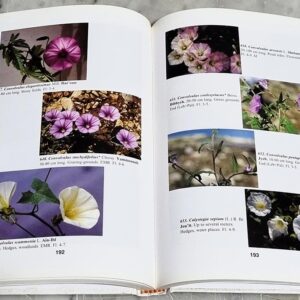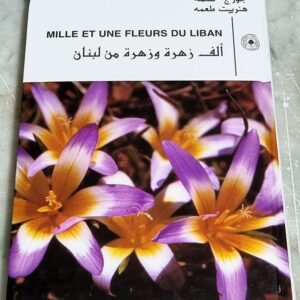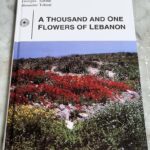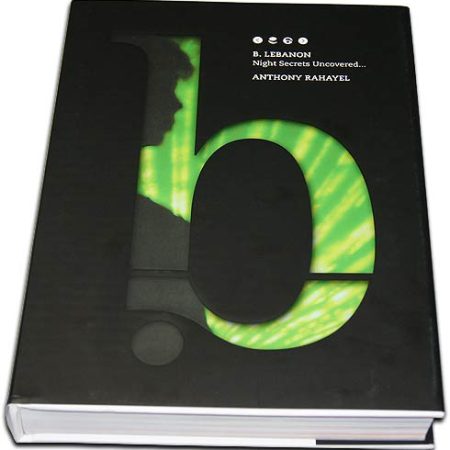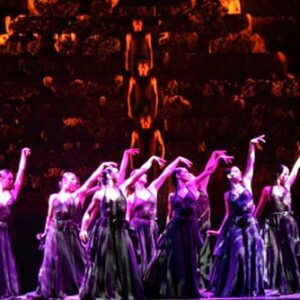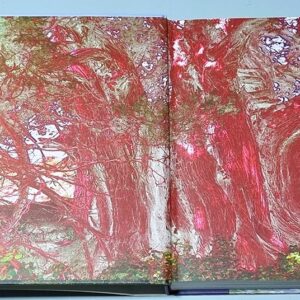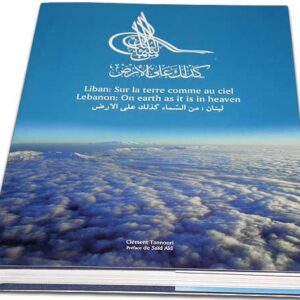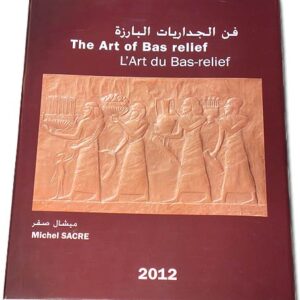Thousand and One Flowers of Lebanon
$ 42.00
A Thousand and One Flowers of Lebanon – Mille et Une Fleurs du Liban
- Description
- Shipping & Return
Description
LebanonPostcard presents A Thousand and One Flowers of Lebanon – Mille et Une Fleurs du Liban – Georges Tohmé and Henriette Tohmé ألف زهرة وزهرة من لبنان – جورج طعمه و هنرييت طعمه – Publications of the Lebanese University – Hardcover book, 24.5×17.5 cm, 313 pages.
Introduction
As biologists, we have travelled all around Lebanon discovering and recording the beauty of this land, highlighting and focusing on ecological problems whenever they exist. Although zoologists by profession, we have always been interested in wild plants, the primary food provider and habitat to many insects. From our experience as educators and researchers, our aim has always been to share our knowledge and our love of Nature with others. Hence the idea of taking colour photographs of this beautiful country and its fauna and flora as a permanent record of this devotion.
The Nouvelle flore du Liban et de la Syrie (Mouterde, 1966, 1970, 1983) is currently considered the best basic reference in identifying Lebanese flora. It mentions the existence of up to 2607 Lebanese species that include 29 ferns, 212 Gramineae and 22 cultivated and naturalised plants. Our studies cite an additional 15 plants from Lebanon that Mouterde had only recorded in Syria. Additionally, we have reported a list of 93 wild plants that have probably disappeared from Lebanon (Tohmé and Tohmé, 2001).
We have thus far collected, preserved, identified and kept a photographic record of about 1650 species and varieties of flowering plants. The decision to publish a user-friendly guide for naturalists was a logical extension of this effort. It aims to assist the amateur in making the right plant identification. A guide of this nature, however, can never be exhaustive due to technical and financial restrictions. We have therefore included 1025 colour photographs of flowers in this guide, reluctantly leaving out the ferns, most trees and gramineous plants. Only seven illustrations of the Gramineae family are presented here. The guide gives one or two photographs of each genus representing the major groups such as Brassicaceae, Fabaceae, Apiaceae, Asteraceae, etc. However, Orchidacea, most of the Iridaceae, Araceae, Lamiaceae and the genus Astragalus, Colchicum, Silene, etc. are almost all represented.
A good field knowledge allows the quick identification of most common species. But to further this knowledge, one needs a rich, well diversified, very well illustrated, bibliographical documentation. Indeed, differences between some species or between varieties are sometimes based on small details not appearing to the naked eye or in photos. In this case, it is necessary to dissect and examine the specimen collected with a lens. For example: interior pubescent corolla, number and form of seeds inside the fruit, number and form of leaflets, the hairy degree of the epidermis, etc. This is how we sometimes limited ourselves to the reproduction of one picture to represent the different species of a genus. When the choice between species had to be made, we have given priority: first to the most abundant species; then to the endemic species of Lebanon; then to the endangered and threatened ones in need of protection from over-grazing and urbanisation; and finally to those endemic plants of the East-Mediterranean Region, localised plants, rare plants, etc.
Next to each illustration, the following information is given: the Latin name as used by Mouterde, taking sometimes into consideration the modern nomenclature and the abbreviations of the names of botanists responsible for describing the species. Also the name of the nearest locality where the picture was taken; the length of stem (in default, the length of leaf or that of perianth); an indication of the composition of the soil, the humidity of the area, the habitat in general, etc.; the endemic distribution of the plant (covering Lebanon or Lebanon and Syria or Lebanon, Syria and Turkey, etc.). The letters EMR indicate that the plant is peculiar to the East-Mediterranean Region in general. Finally, we mention the time of flowering e.g. Fl: 3-6 means: March to June; (M) means medicinal plant. Plants to be protected are followed by (*). Given the permanent degradation of the environment and in order to preserve biodiversity, all plants as well as animals should be protected.
We would like this book to be an accessible companion to all keen amateurs, of all ages. This book is addressed to environmental tourists, as it provides them with a wide number of endemic plants probably previously unknown to them. For those seeking additional technical details, we advice them to consult Mouterde (op. cit.) or Post (Flora of Syria, Palestine and Sinai, AUB, 1932-1934). English names, French or Arabic vernacular names corresponding to scientific names can be found in «Dictionnaire étymologique de la flore du Liban» (Moustapha Nehmé, 2000).
Finally, we wish to express our warmest gratitude to the Lebanese University, which accepted to publish this guide, and to the National Council for Scientific Research which facilitated our field research. We so wish to acknowledge the assistance and contribution of all those in particular our grandson Jaad, who came forward to help in more ways an one thus making our collection of plant richer.
Georges and Henriette Tohmé
LebanonPostcard will be responsible for sending the book you order, through a fast courier with a tracking number, guaranteeing reception of the package. The souvenirs may take three to five days to arrive, according to the country they are sent to.
a. View or Modify What is in Your Shopping Cart.
When in the Shopping Cart area of the site you can view or modify what is in your shopping cart at any time by clicking on the Add More Items/Refresh Totals button along the bottom of your screen.
b. Checking Out and pay for your purchases online.
When you have finished viewing and wish to end your shopping and pay for the items you have selected, click on the Pay & Finish button at the bottom of your screen.
You will be led through a series of secure ordering procedures and will be asked to fill in personal, shipping and payment option information. When this is completed, you will press the Submit Secure Checkout button and your order will be transmitted to LebanonPostcard for fulfillment.
Absolutely not! Right up until the point why you are asked to review the order information you have given us and if it is correct to click on the final Submit Secure Order button, you can abort the order.
If you don't press the Submit Secure Order button then no order information is transmitted to us.
a. Payment by Credit Card
We accept American Express, MasterCard, Visa, Discover, PayPal... etc... for online payments through 2CheckOut.com. Also, arrangements can be made for bank draft and certified check payments by regular post.
b. Payment by Bank Draft and Certified Check
If you would prefer to pay for your purchases by mail, then you have to contact us first so we can give you our account information.
c. We accept as well payment through WesternUnion, RIA, OMT, BOB Finance, Whish Money.
All prices include shipping and handling. LebanonPostcard will be responsible for sending the packages you order, at your charge, through the service D.H.L. / E.M.S. with tracking number code guaranteeing reception of the package.
We ship as soon as possible, but within maximum 4 days after the order is received.
Credit cards are not charged until we actually ship the items. The items may take between one and six days to arrive, according to the country they are sent to.
Packages are sent with track code to guarantee reception, and delay is rare. In the event of non-delivery or delay, nothing can be done for 7 days. At the end of this period, on our being informed, a demand will be made for the package to be traced. If 14 days after the first dispatch there is still no delivery, a second package will be sent free.
Packages inside Lebanon are sent registered through LibanPost to guarantee reception, and delay or non-delivery is rare. In the event of non-delivery, nothing can be done for 6 days. At the end of this period, on our being informed, a demand will be made to LibanPost for the package to be traced. If 12 days after the first dispatch there is still no delivery, a second package will be sent free.
We ship anywhere in the world. Zones and countries we ship to
Yes. You can cancel you order when you receive an email from us confirming your order, you can reply by canceling it.


